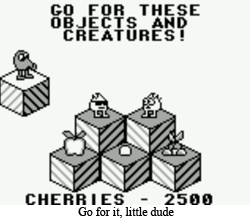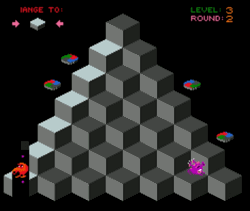 Let’s look at the evolution of gaming/Q*Bert over the years.
Let’s look at the evolution of gaming/Q*Bert over the years.
In 1982, gaming was just taking its first, tentative steps towards Gaming as we know it. Pac-Man and Pong had blazed the trail with their joystick/wheely thing controls, but now we were seeing new and innovative ways to play. Kangaroo, for instance, was a game that was very similar to the likes of Donkey Kong, but added an all-important offensive action to its heroine’s repertoire. Kangaroo could punch out monkeys and apples alike, and one could argue this simple act was the start of “videogame violence” for years to come (sorry, dead monkeys, you gotta start somewhere). And speaking of offensive options, Dig Dug first started digging in ’82, and he had the ability to “pump up” his opponents until they popped. This had the dual purpose of inspiring a generation of bizarre fetishes and featuring a hero that always had the ability to turn the tables on his opponents. Unlike Pac-Man or Mario that had to rely on sporadically distributed powerups, Taizo the Digger was hunted and hunter all in one. This would become the norm for practically all of gaming to come.
But if one game presciently granted a glimpse of gaming of the future, it was Pitfall. Nearly four decades ago, Pitfall Harry explored a large world of tricks, traps, and treasure. Harry had much to do in his (certainly not Mayan) adventure, and, while his moveset was limited, it was contextually sensitive to all sorts of challenges. Harry didn’t simply jump over opponents, he leapt to swing across vines, or hopped over the heads of gators. Pitfall was a revelation for everything its protagonist (and by extension, the player) could do, even if this was still the era of extremely blocky dudes puttering around monochrome backgrounds.
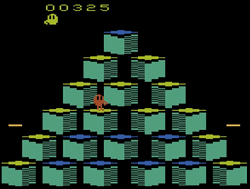 And 1982 also saw the release of Q*Bert. Q*Bert only need move from block to block in a generally diagonal manner. He changes block colors simply by touching blocks, and his only “offensive option” is baiting a malevolent snake into a bottomless pit. Q*Bert does not have a bonus jump, “punch”, or other abilities. Q*Bert simply hops.
And 1982 also saw the release of Q*Bert. Q*Bert only need move from block to block in a generally diagonal manner. He changes block colors simply by touching blocks, and his only “offensive option” is baiting a malevolent snake into a bottomless pit. Q*Bert does not have a bonus jump, “punch”, or other abilities. Q*Bert simply hops.
Ten years later, in 1992, the face of gaming had irrevocably changed. The arcade gave way to the domination of the console, and now Sega and Nintendo were battling it out. But there was the Personal Computer, too! Wolfenstein 3D had just been released, and the whole of the FPS genre was just starting to congeal into Doom (to be released the next year). For some, the “3-D” nature of first person shooters promised to be what “the future of gaming” was always expected to be: fully immersive fighting (through the legions of Hell/nazis, apparently).
But away from the monitor and back at the television, Sonic the Hedgehog 2 was pushing the boundaries of the genre that had become known as platforming. Sonic could run, jump, and dash; but he did it at speeds that could not have even been imagined ten years prior. And this latest Sonic allowed for two player simultaneous play! Just like in those competitive fighting games that had been making the scene! And Mortal Kombat was the most prominent “new fighter” of ’92. Now there was a radical shift in gaming! Kangaroo might have punched out a monkey, but, for better or worse, she never tore the head off of an opponent. And look at all those buttons! “Punch” is a thing of the past: Sub-Zero had a variety of punches, kicks, and fireballs (well, snowballs) at his disposal. You didn’t just need an instruction manual for your average fighting game, you needed a strategy guide (thanks, Nintendo Power!).
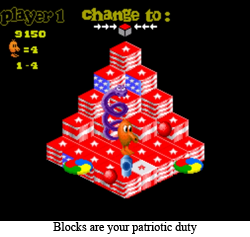 But while we’re considering strategy, let us also consider Super Mario Kart. Mario had cameoed in a sports title here or there over the years (he got really good at Golf, apparently), but he mostly just starred in his own adventures that involved running and jumping. Super Mario Kart was a great success as a fun racing game, but it also showcased how a videogame mascot could shift all their normal “verbs”, but still be unmistakably that familiar mascot. Mushrooms can make you super tall, or they can give you a speed boost. Turtle shells can become projectiles divorced from their turtles. And anyone that has ever played any Mario Kart knows the difference between a Starman that allows you to mow down goombas and one that allows you to speed to the finish line. Mario Kart showed that even the most rigidly defined mascot could be anything, and paved the way for the Sonic Racing or unprecedented crossovers of today.
But while we’re considering strategy, let us also consider Super Mario Kart. Mario had cameoed in a sports title here or there over the years (he got really good at Golf, apparently), but he mostly just starred in his own adventures that involved running and jumping. Super Mario Kart was a great success as a fun racing game, but it also showcased how a videogame mascot could shift all their normal “verbs”, but still be unmistakably that familiar mascot. Mushrooms can make you super tall, or they can give you a speed boost. Turtle shells can become projectiles divorced from their turtles. And anyone that has ever played any Mario Kart knows the difference between a Starman that allows you to mow down goombas and one that allows you to speed to the finish line. Mario Kart showed that even the most rigidly defined mascot could be anything, and paved the way for the Sonic Racing or unprecedented crossovers of today.
And then there was Q*Bert for Gameboy, and Q*Bert 3 for Super Nintendo, both released in 1992. Q*Bert only need move from block to block in a generally diagonal manner. He changes block colors simply by touching blocks, and his only “offensive option” is baiting a malevolent snake into a bottomless pit. Q*Bert does not have a bonus jump, six punch buttons, or other abilities. Q*Bert simply hops. Sometimes there are a variety of new colors and backgrounds, though. You know, at least on the system that has color.
Let’s hop forward seven years. By the time 1999 rolled around, the “mascot wars” of the previous console generation had concluded, and newcomer Sony was riding high with the Playstation and the serious, cinematic Final Fantasy franchise. This was the year we were finally going to see the sequel to Final Fantasy 7, Final Fantasy: Whatever, and it pushed the boundaries for what was expected of the JRPG genre. Have you ever heard of Triple Triad? Guardian Forces? Dog Missiles? If you haven’t, don’t worry about it, it was all only around for one game, but it did establish that you could have complicated battle systems that were only relevant for one title. Fight, magic, item wasn’t the only fish in the sea, anymore, let’s get ready to get some gambits up in here!
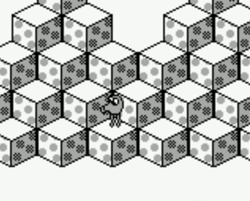 This was also a time when gaming was getting more serious… but “serious” as more of a teenager’s definition. Tony Hawk’s Pro Skater allowed a “real human” avatar to perform intricate skateboarding tricks in a universe that apparently had unlimited and instant healthcare. Silent Hill allowed a player to explore the depths of the human psyche in a world that was going to be complete in a few years with the introduction of a certain pyramid headed fellow that really knew how to swing around half a pair of scissors. Or maybe you just wanted to be the Driver, and cruise around realistic (enough) cities? In a way, these games were just as big on the fantasy as Mario (no, you cannot drive a car into a building in reality and continue to have a good time), but they were a lot more “real” than anything Pitfall Harry ever did.
This was also a time when gaming was getting more serious… but “serious” as more of a teenager’s definition. Tony Hawk’s Pro Skater allowed a “real human” avatar to perform intricate skateboarding tricks in a universe that apparently had unlimited and instant healthcare. Silent Hill allowed a player to explore the depths of the human psyche in a world that was going to be complete in a few years with the introduction of a certain pyramid headed fellow that really knew how to swing around half a pair of scissors. Or maybe you just wanted to be the Driver, and cruise around realistic (enough) cities? In a way, these games were just as big on the fantasy as Mario (no, you cannot drive a car into a building in reality and continue to have a good time), but they were a lot more “real” than anything Pitfall Harry ever did.
And if you wanted some fantasy, don’t worry, you still had the likes of Ape Escape or Donkey Kong 64 to hold you over. DK64 saw the collectathon at its most… collecty, and showcased all the different ways Kongs can run, jump, and shoot on their way to an ultimate goal of wringing out 12,000,000 (monotonous) hours of gameplay. And Ape Escape was no simple monkey game, it was a sneak and capture event closer to Metal Gear than Donkey Kong. Even visually “childish” games in 1999 weren’t so simple.
And then there was Q*Bert for Playstation. Q*Bert only need move from block to block in a generally diagonal manner. He changes block colors simply by touching blocks, and his only “offensive option” is baiting a malevolent snake into a bottomless pit. Q*Bert does not have a bonus jump, “punch”, or other abilities. Q*Bert simply hops. This time there was an adventure mode, but that was just an excuse to stick cinema scenes on either side of a world. Everything else was just Q*Bert hops.
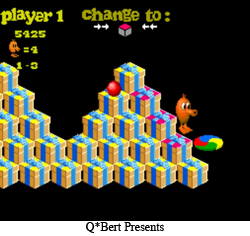 The following five years allowed for a number of innovations in gaming. In 2004 we saw Grand Theft Auto: San Andreas, which was the first Grand Theft Auto to feature extensive customization to its grand, open world. It also had planes, bazookas, and the opportunity for your C.J. to cosplay as The Notorious B.I.G. for the entire adventure. It is arguable that this Grand Theft Auto went too far into the whacky territory after its sequels eventually tried to rein everything back in with sad Russians in GTA4 and sad dads in GTA5, but the Saints Row franchise carried that whacky football straight to the end zone. Gaming had started goofy, become serious, and then migrated back to goofy all over again.
The following five years allowed for a number of innovations in gaming. In 2004 we saw Grand Theft Auto: San Andreas, which was the first Grand Theft Auto to feature extensive customization to its grand, open world. It also had planes, bazookas, and the opportunity for your C.J. to cosplay as The Notorious B.I.G. for the entire adventure. It is arguable that this Grand Theft Auto went too far into the whacky territory after its sequels eventually tried to rein everything back in with sad Russians in GTA4 and sad dads in GTA5, but the Saints Row franchise carried that whacky football straight to the end zone. Gaming had started goofy, become serious, and then migrated back to goofy all over again.
And speaking of marginally goofy, this was the year we saw Fable, which touted a rich morality system and a story that was different every time you played it. Did that actually happen? Well, not really, but it did seemingly start the trend of games that bet their whole asses on save baby/eat baby morality. It was no longer enough to run, jump, and punch; now you had to determine whether or not you were doing all those things while simultaneously becoming Mecha Hitler. Or Mecha Mother Theresa? You’ve got choices!
But on the simpler side of things, there was Katamari Damacy. This straightforward little game featured a protagonist that could only roll around a ball, but that ball could grow from the size of a paperclip to roughly the girth of a galaxy. And, more importantly than the gameplay, it was released for a whole $20, kickstarting the (now standard) belief that not every videogame had to be a AAA, 40 hour feature. Before internet connections fully graduated from 56K, Katamari Damacy showed us a glimpse of the future of downloadable titles.
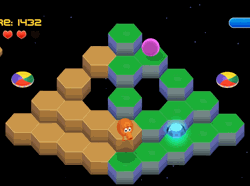 And speaking of downloadable, this year also saw an official Flash (RIP) version of Q*Bert. In a game that would be ported to “real” Windows a year later, Q*Bert only need move from block to block in a generally diagonal manner. He changes block colors simply by touching blocks, and his only “offensive option” is baiting a malevolent snake into a bottomless pit. Q*Bert does not have a bonus jump, “punch”, or other abilities. Q*Bert simply hops. At least this Q*venture was free.
And speaking of downloadable, this year also saw an official Flash (RIP) version of Q*Bert. In a game that would be ported to “real” Windows a year later, Q*Bert only need move from block to block in a generally diagonal manner. He changes block colors simply by touching blocks, and his only “offensive option” is baiting a malevolent snake into a bottomless pit. Q*Bert does not have a bonus jump, “punch”, or other abilities. Q*Bert simply hops. At least this Q*venture was free.
Now we fast-forward a decade to 2014. What innovations did this year hold for gaming? Well, we wound up skipping the exact year for a lot of big’uns from this epoch, so we’re left with staring straight at Dark Souls 2. Did you ever hear about Dark Souls? It’s the Dark Souls of Bloodborne games. Love it or hate it, Dark Souls impacted gaming in more ways than we will ever admit, arguably revitalizing the general gameplay of the rogue-like and encouraging increasing your own personal gaming skills while marginally leveling up your chosen hero. In a similar manner, this was the year we saw Bayonetta 2, a shining example of the likewise “hardcore” stylish action genre. Gaming could be slow and methodical or fast and elegant, but, in both cases, it was a little more complicated than guiding a puck through a maze.
And if you still wanted the mascots of yore, don’t worry, they were represented, too. If you wanted to see everybody fight everybody, Super Smash Bros 4 WiiU/3DS was released in 2014. Smash Bros was always a shining example of videogame protagonists leaving their usual genre and sailing into something completely different (Star Fox left his ship!), but Smash 4 would eventually grow and mutate to be a veritable yearbook of every character that had ever mattered in gaming (sorry, Geno, you don’t matter). And if you wanted something new from “cartoony” characters, this was also the year that Shovel Knight proved Kickstarting retro platformers was wholly viable, and could have amazing, enduring results. Come to think of it, Shovel Knight was partially inspired by Dark Souls, too…
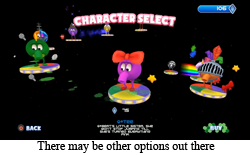 But there was one game released that year that was not inspired by Dark Souls. Q*Bert Rebooted, seemingly rebooted to promote an Adam Sandler vehicle, was a game where Q*Bert only need move from block to block in a generally diagonal manner. He changes block colors simply by touching blocks, and his only “offensive option” is baiting a malevolent snake into a bottomless pit. Q*Bert does not have a bonus jump, shovel, or other abilities. Q*Bert simply hops. He also hopped to nearly every platform available, so this one is still downloadable on modern consoles.
But there was one game released that year that was not inspired by Dark Souls. Q*Bert Rebooted, seemingly rebooted to promote an Adam Sandler vehicle, was a game where Q*Bert only need move from block to block in a generally diagonal manner. He changes block colors simply by touching blocks, and his only “offensive option” is baiting a malevolent snake into a bottomless pit. Q*Bert does not have a bonus jump, shovel, or other abilities. Q*Bert simply hops. He also hopped to nearly every platform available, so this one is still downloadable on modern consoles.
And Q*Bert returned for the most recent time in 2019 for iOS. Do we need to review the gaming breakthroughs of such a recent year? Fire Emblem: Three Houses and its perfect blend of chess and dating simulation? Super Mario Maker 2 and its ability to grant the player full creative control over familiar gameplay? Untitled Goose Game and its goose? Whatever the hell happens in Sekiro? (I gather it is a photography simulator.) 2019 was an amazing year for gaming where we not only had all this, but also Q*Bert. And what did Q*Bert do? He moved from block to block in a generally diagonal manner. He changed blocks colors. He baited a snake into a pit. Q*Bert only knows hops.
He was Q*Bert. He is Q*Bert. The face of gaming may irrevocably change, but Q*Bert is Q*Bert forever.
@!#?
FGC #562 Q*Bert
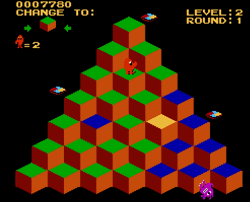 System: I’m pretty sure the lil’ Bert appeared on nearly every console system, give or take a few outliers. Playstation 2? Sega Genesis? And I’m pretty sure he wasn’t on Atari Lynx, either. Other than that, there’s probably some Q*Bert in some form on your preferred console.
System: I’m pretty sure the lil’ Bert appeared on nearly every console system, give or take a few outliers. Playstation 2? Sega Genesis? And I’m pretty sure he wasn’t on Atari Lynx, either. Other than that, there’s probably some Q*Bert in some form on your preferred console.- Number of players: One Q*Bert, but two people can take turns if they are so inclined.
- Don’t make a sound: Q*Bert’s claim to fame has always been the bizarre recordings that approximate the sound an orange monster man might make when brained with a purple marble. Unfortunately, playing Q*Bert in the year 2021 just reminds me that I never want to hear from a belligerent orange creature ever again.
- Hey, what about Q*Bert’s Qubes: The only Q*Bert to truly mix up traditional Q*Bert gameplay was… not all that different. It basically just added the idea of “rotating” cubes according to the direction Q*Bert hops (as opposed to one simple, all-purpose tap), and added a handful of new enemies (there may have been a crab). Other than that, the way it “separated” the blocks made the game a lot more difficult to visually parse, and there’s probably a reason this Q*title is generally forgotten and ignored.
- Did you know? Q*Bert for Playstation started with a cinema scene based in Q*Bert’s blocky little world. Weird thing? His weirdass universe looks a lot like modern Minecraft. Did Steve colonize Q*World? Is that the secret origin of the franchise?
- Would I play again: Q*Bert is great for a whole five minutes before you remember it’s just goddamned Q*Bert. I will probably waste those five minutes again in the future.
What’s next? Random ROB has chosen… Wallachia Reign of Dracula! Or did ROB actually choose Bloodstained: Classic Mode? Actually, it’s both! We’re going to have a double header next! Please look forward to it!
